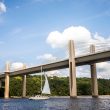Cleaning up bus service
On Dec. 21, 2004, Albuquerque, N.M., rolled out a fleet of 12 electric-diesel hybrid buses for its new express bus service through downtown. The city’s transit authority, ABQ RIDE, introduced the “Rapid Ride” line to relieve overcrowding on its most-used route and to increase ridership.
More than one-third of Albuquerque’s bus riders — about 200,000 a month — travel on Route 66, which serves Central Avenue through downtown. During peak times, many of the route’s buses were standing room only.
After researching public transportation in other cities, Albuquerque officials decided to offer a limited-stop service to provide faster, more convenient travel along Central Avenue. Rapid Ride also might lead to light rail or bus rapid transit service, which city officials currently are studying. “Rapid Ride is giving the city its first taste of modern, convenient public transportation — a must if we’re going to lure people out of their cars,” Mayor Martin Chávez says.
Rapid Ride buses operate in mixed-use travel lanes but are equipped with a signal-priority system that triggers or extends green lights. That system, along with buses arriving every 10 minutes at major destinations, makes travel time on Rapid Ride comparable to that of a passenger vehicle traversing the same 11-mile route.
Planners adjusted and added other bus routes to connect with Rapid Ride and to attract new riders. Fares for Rapid Ride are the same as those for regular buses, and all transfers and passes are valid on the new service. “Rapid [Ride] offers current riders the opportunity to decrease their time on the bus,” says ABQ RIDE Director Peter Behrman. “They can use the Rapid for the majority of their trip and, if necessary, transfer to the local to complete it.”
Rapid Ride’s stops are situated near popular restaurants and shopping centers. “I work downtown and eat lunch out a few times a week,” says resident Claude Morelli. “My choices were pretty limited, but now I can get on the Rapid and go to the University area for lunch and still get back to work in time because I don’t have to take my car out of the garage or spend time looking for a place to park.”
The 60-foot-long, articulated buses, manufactured by Winnipeg, Manitoba, Canada-based New Flyer Industries, are powered by General Motors’ hybrid technology. They use ultra-low sulfur diesel fuel instead of regular low-sulfur diesel fuel used by conventional buses. The hybrid buses are planned to reduce certain particulate emissions by up to 90 percent, while producing much lower hydrocarbon and carbon monoxide emissions than conventional diesel buses.
The new buses notify passengers when the bus is approaching the next station and count passengers to help identify segments where more service might be needed. Buses also are equipped with a global positioning system, security cameras and microphones. Each bus has a front-mounted bicycle rack that can accommodate three bikes at a time. “We’re very proud of Rapid Ride,” Chávez says. “We’ve created a revolution in public transportation for Albuquerque, and this is only the beginning. We will continue to make innovative choices and implement new programs to give our city the best system we possibly can.”



















